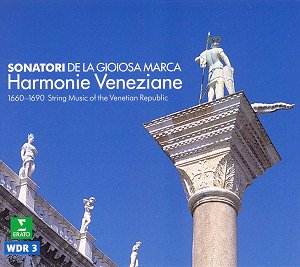The music in Venice
between Monteverdi and Vivaldi doesn’t
get much attention. When I looked into
a book on 500 years of Venetian music
the chapter on the 17th century contained
just one page regarding this period.
Only two composers were mentioned: Cavalli
and Barbara Strozzi. Even in ‘The New
Grove’ the article on Venice devotes
very little space to the second half
of the 17th century, and then mainly
concentrates on the opera. This was
certainly an important genre, apart
from the religious music composed for
the many churches in the city, among
them the San Marco. But there were quite
a number of composers who wrote chamber
music as well. Among the most important
are those whose works are recorded by
the Sonatori de la Gioiosa Marca, an
ensemble which regularly points at music
which is often neglected.
One of the features
of music life in Venice at this time
is the differences in style between
composers, and even within the oeuvre
of composers. There were influences
from outside Italy. Just like Italian
operas had been performed in Paris earlier
in the century – for instance operas
by Cavalli – French music was performed
in Venice. Giovanni Legrenzi, for example,
directed performances of music by Lully.
Another cause of the influence from
abroad was the economic and political
decline of Venice. As a result instrumental
music was mostly commissioned by foreign
patrons. And in order to please them
composers adapted their compositional
styles to what these patrons liked.
The troublesome economic
situation also encouraged composers
to travel abroad to look for employment.
Giovanni Legrenzi held posts in Bergamo
and Ferrara and tried to become Kapellmeister
at the imperial court in Vienna.
Ziani went to Austria
and travelled as far as Dresden to perform
some of his theatre and church music.
And then there were
foreigners coming to Venice. The city
may have deteriorated economically,
it was still a place of huge cultural
reputation. In the case of Johann Rosenmüller,
it wasn’t only artistic reasons which
drove him to Venice. Once a promising
performer and composer he had a good
prospect of becoming cantor of the Thomasschule
in Leipzig. But in 1655 he was jailed
on suspicion of paedophelia. He was
able to escape and went to Venice, where
he became a respected musician and composer.
The least well known
of the composers represented on this
disc is Carlo Antonio Fedeli, called
‘Saggion’. He developed from violone
player to ‘maestro de’ concerti’ at
San Marco.
The CD opens with a
Sinfonia to an opera by Francesco Cavalli,
Monteverdi’s pupil and his successor
as Venice’s main opera composer. But
this opera was never performed, since
it was considered too old-fashioned.
Nevertheless, some
of the instrumental music recorded here
contains old-fashioned traces as well.
The only work by Fedeli on this disc
combines two techniques which are rooted
in the 16th century: the polychoral
style and the use of ‘echo’-effects.
The four violins are divided into two
‘choirs’ of two violins each: one in
the forefront and one acting as ‘echo’.
In the consecutive sections the violins
dialogize with each other, and then
with their respective echoes.
The two works by Ziani
are strongly contrasting. The Sonata
XV is characterised by counterpoint,
with fugal sections at the start and
the end and a very expressive slow section
in the middle. His Sonata VIII is much
lighter and theatrical in character.
Most of Legrenzi’s
works concentrate on the upper parts;
two of the four pieces recorded here
don’t have parts for the viola. In his
works we find connections with the past
too: the Corrente IX, which closes this
disc, is based upon the bass line from
the 16th century ‘aria del Gran Duca’.
A peculiar piece is
the ‘Sonata V a 4 viole da gamba’ which
was commissioned in Vienna. The addition
‘o come piace’ justifies a performance
in a more ‘conventional’ scoring of
2 violins, viola and cello, but the
character of this sonata clearly reflects
the intention to be played on four viole
da gamba, and I would love to hear it
that way.
Rosenmüller may
have been influenced by the music of
other Italian composers, his music still
reflects his German musical education.
In particular the ‘Sinfonias’ from the
‘Sonate da camera’ of 1667 are written
in the ‘stylus phantasticus’ characteristic
of the North-German style of composition.
The performance does
this music full justice. The ensemble
has a fine sense for the phrasing of
the individual pieces and is realising
the contrasts within the compositions
quite nicely. They also understand the
German origin of Rosenmüller; his
music is more clearly articulated, with
a good sense of the hierarchy of the
notes within the phrases.
The fast movements
or sections are played with great rhythmic
flair, with strong support from the
basso continuo. The more austere pieces,
for example Ziani’s Sonata XI, are played
with a lot of expression. And there
is a beautiful clarity of the lines
where the music has a polyphonic character.
In short, this is an
excellent recording. The argument for
this forgotten music couldn’t be more
eloquent and convincing.
Johan van Veen

